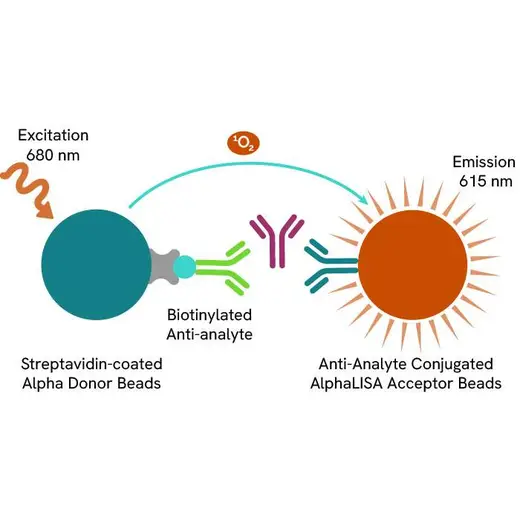
AlphaLISA Human & Rat IL-22 Detection Kit, 5,000 Assay Points


 View All
View All
AlphaLISA Human & Rat IL-22 Detection Kit, 5,000 Assay Points














The AlphaLISA™ Human/rat IL-22 Detection Kit is designed for detection and quantitation of human or rat interleukin 22 in cell culture media or serum using a homogeneous (no-wash steps, no separation steps) assay.
For research use only. Not for use in diagnostic procedures. All products to be used in accordance with applicable laws and regulations including without limitation, consumption and disposal requirements under European REACH regulations (EC 1907/2006).
| Feature | Specification |
|---|---|
| Application | Protein Quantification |
| Dynamic Range | 10 - 1,000,000 pg/mL |
| Limit of Detection | 18 pg/mL |
| Limit of Quantification | 65 pg/mL |
| Sample Volume | 5 µL |
The AlphaLISA™ Human/rat IL-22 Detection Kit is designed for detection and quantitation of human or rat interleukin 22 in cell culture media or serum using a homogeneous (no-wash steps, no separation steps) assay.
For research use only. Not for use in diagnostic procedures. All products to be used in accordance with applicable laws and regulations including without limitation, consumption and disposal requirements under European REACH regulations (EC 1907/2006).







AlphaLISA Human & Rat IL-22 Detection Kit, 5,000 Assay Points







AlphaLISA Human & Rat IL-22 Detection Kit, 5,000 Assay Points







Product information
Overview
Formats:
- Our HV (100 assay point) kits allow you to run 100 wells in 96-well format, using a 100 µL reaction volume (10 µL of sample).
- Our 500 assay point kit allows you to run 500 wells in 96-well or 384-well format, using a 50 µL reaction volume (5 µL of sample).
- Our 5,000 assay point kit allows you to run 5,000 wells in 96-well or 384-well format, using a 50 µL reaction volume (5 µL of sample).
Features:
- No-wash steps, no separation steps
- ELISA alternative technology
- Sensitive detection
- Broad sample compatibility
- Small sample volume
- Results in less than 3 hours
- Half the time of an ELISA assay
IL22 is a member of a group of cytokines called the IL10 family (including IL19, IL20, IL24, and IL26), a class of potent mediators of cellular inflammatory responses. IL22, ~20 kDa in size, is produced by activated DC,TH1, TH17, and NK cells acting primarily on epithelial cells such as respiratory and gut epithelial cells.. On binding to its receptor (IL22R1), which is associated to the interleukin 10 receptor 2 (IL10R2), IL22 promotes activation of multiple signals including the STAT1, STAT3, ERK, p38, and JNK pathways. IL22 can contribute to immune disease through the stimulation of inflammatory responses, S100s and defensins. In some contexts, the pro-inflammatory versus tissue-protective functions of IL22 are regulated by the often co-expressed cytokine IL17A
AlphaLISA technology allows the detection of molecules of interest in a no-wash, highly sensitive, quantitative assay. In an AlphaLISA assay, a biotinylated anti-analyte antibody binds to the Streptavidin-coated Donor beads while another anti-analyte antibody is conjugated to AlphaLISA Acceptor beads. In the presence of the analyte, the beads come into close proximity. The excitation of the Donor beads causes the release of singlet oxygen molecules that triggers a cascade of energy transfer in the Acceptor beads, resulting in a sharp peak of light emission at 615 nm.
Specifications
| Application |
Protein Quantification
|
|---|---|
| Automation Compatible |
Yes
|
| Brand |
AlphaLISA
|
| Detection Modality |
Alpha
|
| Dynamic Range |
10 - 1,000,000 pg/mL
|
| Limit of Detection |
18 pg/mL
|
| Limit of Quantification |
65 pg/mL
|
| Product Group |
Kit
|
| Sample Volume |
5 µL
|
| Shipping Conditions |
Shipped in Blue Ice
|
| Target |
IL22
|
| Target Class |
Cytokines
|
| Target Species |
Human
Rat
|
| Technology |
Alpha
|
| Therapeutic Area |
Inflammation
|
| Unit Size |
5,000 Assay Points
|
Image gallery






AlphaLISA Human & Rat IL-22 Detection Kit, 5,000 Assay Points






AlphaLISA Human & Rat IL-22 Detection Kit, 5,000 Assay Points






Video gallery

AlphaLISA Human & Rat IL-22 Detection Kit, 5,000 Assay Points

AlphaLISA Human & Rat IL-22 Detection Kit, 5,000 Assay Points

Resources
Are you looking for resources, click on the resource type to explore further.
Cytokines play a vital role in both innate and adaptive immunity and are known for their ability to exert diverse functions on...


How can we help you?
We are here to answer your questions.






























